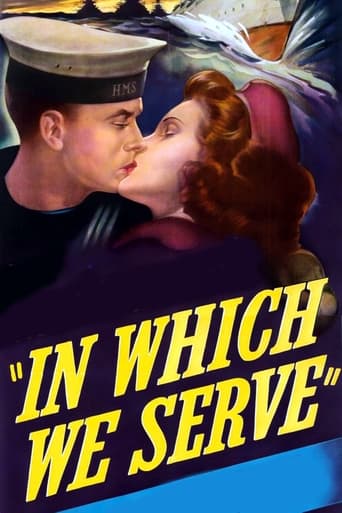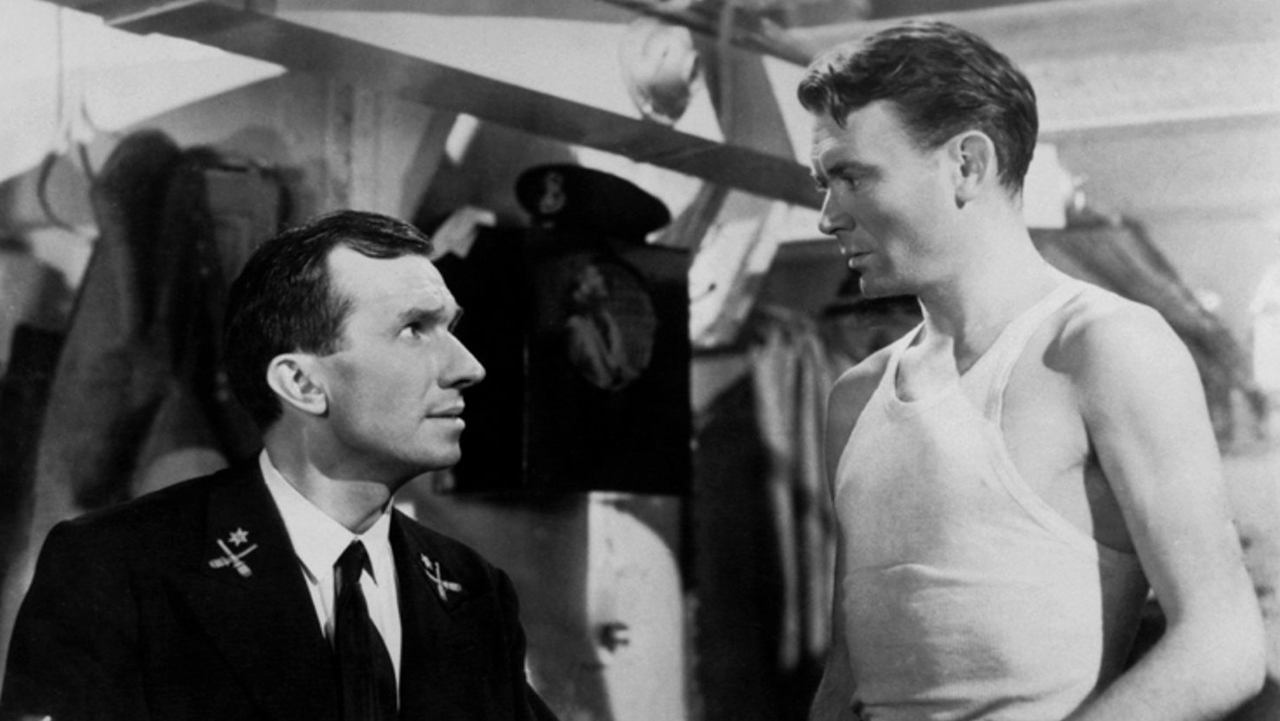JLRVancouver
Although clearly made as a home-front morale builder, "In Which We Serve" remains an outstanding naval action film. Written and co-directed (with David Lean) by Noel Coward, who also stars as Captain Kinross, the film grew out of Coward's desire to contribute to the war effort. "In Which We Serve" follows the exploits of the HMS Torrin, a fictional destroyer serving in the Atlantic and Mediterranean in the early years of the war. Shot with the cooperation of the navy, the on-board footage is highly detailed and realistic, and the integration of actual footage, miniatures and sets is extremely well done. As is typical of WW2 era films, there is an great emphasis on the camaraderie and willing sacrifice of the men serving on the ship but the boredom, danger, and terror of combat duty are also highlighted. Not surprisingly, the Germans are mostly seen machine-gunning lifeboats (extremely well done scenes) and Blitzing women. The home front scenes, featuring wives and girlfriends, are also quite well done and the film is pleasantly free of the dated 'comic relief' that mars many contemporary war movies. The cast is uniformly excellent as is the story (based on Lord Mountbatten's experiences as captain of the HMS Kelly), script, and direction
l_rawjalaurence
Based mostly on the experiences of Lord Mountbatten on HMS Kelly, IN WHICH WE SERVE is a classic British flag-waver from 1943, attesting to the bravery and sheer grit of captain and crew as they struggle to survive after their ship has been sunk by a German torpedo. Structured as a series of flashbacks, the narrative focuses on different members of the crew from different socio-economic backgrounds: the bourgeois Captain Kinross (Noel Coward) leading a comfortable family life with his wife (Celia Johnson), and two children (Daniel Massey, Ann Stephens); the middle-class Chief Petty Officer Hardy (Bernard Miles), living with his wife (Joyce Carey) and her mother; and the working-class Ordinary Seaman Blake (John Mills) living in a modest terraced house with his family. While the film is redolent of the class-consciousness characteristic of that period (there is little no possibility of anyone wanting to improve themselves), it depicts a changing world in which everyone pulls together, both on the battle-front and at home. The loyalty and dedication of Kinross' crew is quite admirable, even under adverse circumstances: when one member (Richard Attenborough) steps out of line and neglects his duty, he is sternly admonished and never does it again. On the Home Front the crew members' wives and families stoically endure the pain of separation, while realizing that such experiences have to be endured during wartime. Even when Hardy loses his wife and mother (both victims of the Blitz), he vows to carry on at his post regardless. As Kinross, Noel Coward is a model of rectitude, as he tries to do the best for his crew; yet from the clever use of close-up, we understand the depth of emotion lurking underneath that British reserve, especially at the end when he says goodbye to his crew- members. IN WHICH WE SERVE is noticeably unsentimental in its approach: co-directors Coward and David Lean are not frightened to represent the seamier sides of life in World War II, while paying tribute to the bravery of everyone, whether on active service or remaining at home. It is this detachment from the material that makes the film so watchable, even after seventy years.
secondtake
In Which We Serve (1942)A curiously different and really moving film about World War II, directed by two top British talents, Noel Coward and David Lean. It's filmed in the thick of the actual naval war and so might be unofficially called a propaganda film. (Though not made by the government, there was a lot of influence and assistance.). It clearly has a sense of presenting the British war effort at its best. But it's also complicated, filled with sadness alongside heroism and, perhaps most of all, selflessness. Both by soldiers and by their women left behind. The war in 1942 was not looking great for the Brits.Coward co-directs but also is the leading man, and he's an established actor from both film and stage at this point. Lean, whose huge career as a director is all ahead of him, is in charge of the action sequences and this is his first attempt at directing--for which he won awards. If there is a sentimental side to some of the Coward directed scenes it's partly because of when it was shot. Try to imagine the audience suffering from bombings and having their loved ones in battle. We see it now with very different eyes.In fact, it is hard to imagine how a wife or mother could watch this at all. The basic structure is that the ship goes out to sea with a bunch of men and then disaster strikes, and the rest of the movie is a series of flashbacks to the home lives of the men, and to the women who are dreading seeing their men go off to sea. It's actually about the very sadness of the people sitting in the audience.The filming is rather different between the two directors. Coward understands a traditional kind of culture well, with conversation and interpersonal nuance. Lean captures a more direct emotional energy, and lots of vivid action. Normally two directors means problems, but here it's divided naturally.Eventually the movie wears its formula, back and forth with flashbacks, pretty hard. But it's so well done you don't much mind. An emotional, finely seen movie, and surprisingly valid even now.
rhinocerosfive-1
Opportunities to see Noel Coward recite Noel Coward were necessarily inhibited by his death, but he has left among his filmed artifacts this stunning little achievement, perhaps the quietest war film, probably the most British. To be sure, it veers maudlin once or twice, and the whole production is suffused with the blood of righteousness - but not self-righteousness. This is the kind of movie that makes me want to join the Navy, I who get seasick in the bath.How does a middle-aged homosexual song-and-dance man support the war effort? By producing a bang-up answer to Wyler and Ford, a vivid recruitment poster for the side of decency and respect. Brutal, tender, horrible, and full of hope, IN WHICH WE SERVE sings the victory song of both shellfire and home fire without mention of glory or distinction. Noel Coward's acting is a marvel of disinterested conviction. Nobody could speak faster, or with more precision, and that with the stiffest of upper lips.No one wrote dialog at once so arch and comfortable, either, except maybe Kipling. Coward celebrates the most sophisticated level of civilization, the blithe, eloquent man of society who has managed not to become jaded. He embraces his England with a respectfully familiar pinch on the cheek, and he kisses her with the most restrained of passions in front of the children. But he also loves with all his heart the simple proletarian bedrock, and he allows the working classes to display as much humanity and emotion as he denies his own character.There is much stage-like, not to say stagey, in the production, which shouldn't be very surprising given its principal antecedents. The film is sometimes expressionistic in design, the angles and sets a terrifying collage of unsettling, theatrical images in contrast to the reassuring tea cozy and the ramrod-straight captain on the quarterdeck. The symbols are profoundly simple and the effect is disarmingly true. As Coward says over a drink, "Perfect; it's not a bit too sweet." Well, it is rather, but mix another pitcher of Bovril and sherry and don't complain, there's a good chap.



 AD
AD




